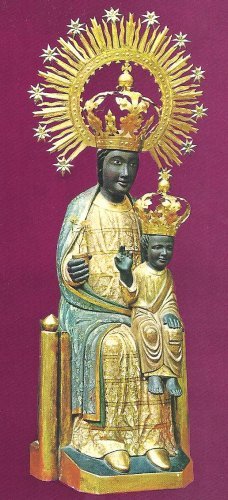Sant Llorenç de Morunys
Mare de Déu dels Colls
(Mother of God of the Mountain Pass¹)
In the Monastery of Sant Llorenç de Morunys, in the center of the village, about 40 minutes North-East of Solsona,Catalunya, about 70 cm, 1942 copy of ancient original destroyed during the Spanish Civil War (1936-39).
The Mother of God of Colls is enthroned in the most amazing Baroque altar called 'the Altar of Colls'.² It fills a whole chapel of the otherwise very simple Romanesque church. It's like a cave lit up with a golden light from Heaven. That light has a story to tell, the story of salvation through Mary. It depicts words from the 'Hail holy Queen' (Salve Regina) prayer, the litany of Loreto, and from the Magnificat. I particularly like the detail (see photo below) where God the Father blesses Mary as she shows Jesus how to breast feed the world, i.e. how to nourish and nurture it with your essence.
The church is part of a defunct monastery that was founded in 885 A.D. by the Benedictines. A few architectural remnants of that time have survived, but most of the church is from the 11th century.
Sant-Llorenc altar
Legend has it that one day two monks went out into the mountains, seeking the tranquility of God’s creation. A shepherd watched them from some distance. At one point he overheard them argue with a person who seemed to stand near them. The shepherd couldn’t see the person, but when the two monks left alone he went to find out who they had been talking to. With great joy he discovered that it was this Black Madonna.
Later the shepherd witnessed a crowd of people who came and got the Madonna with a devout procession. From then on she resided in the monastery church.
Nobody knows when these events occurred, but from time immemorial the local population has carried their Black Madonna in a yearly procession on the Day of Prayers (Día de las Rogaciones) to the place where she was found.
Morunys, breastfeeding
Sant-Llorenc, rock
Sant-Llorenc, fountain
In front of the church clear mountain water flows from a vulva shaped rock into a fountain and people take it home to drink. Black Madonnas are often next to ancient sacred wells and the earth used to be perceived as the body of the Goddess. Moist clefts were her vulva, round hills her breasts, and caves her womb.⁴
Footnotes:
1. The Catalan word colls also means neck, but here it is used in the sense of mountain pass, because of where she was found.
2. A sign on the wall near the Black Madonna explains that the artist Josep Pujoli Juhí created this master piece around 1773-1784 out of black stone covered with gold paint. The altar was badly mutilated during the Spanish Civil War (1936-39) but restored afterwards.
3. Miquel Ballbè i Boada, Las Vírgenes Negras y Morenas en España Vol. 1, Gafiques ISTER, Moia/Terrassa: 1991, pp.327-8.
4. Maureen Concannon, The Sacred Whore: Sheels Goddess of the Celts, The Collins Press, Cork: 2004, pp. 22-4






